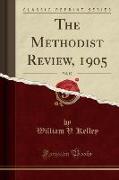METHODIST REVIEW 1905 VOL 87 (
BücherAngebote / Angebote:
Excerpt from The Methodist Review, 1905, Vol. 87Their purchases at the noted Winchester fair in September. T ich borne Park, notorious for its great lawsuit, is near New Alresford. At Chawton, about a mile before we reach Alton, is Jane Austen's cottage, where she lived for eight years and wrote the novels which have won her lasting fame. Gilbert White's home at Selborne is four or five miles to the right. After leaving Alton the pilgrims followed the side of the river W ey till they came close to F arnham, which has been the home of the bishops of Winchester since the days of Saint Swithin. Henry of Blois built the first palace. The lawn, with its stately cedars and grass-grown moat, deserves a visit, but the most interesting part of the building is the fine old keep, with its massive buttresses and thirteenth-century arches, commanding a wide view over the elm avenues of the park and the great extent of wild commons which stretch eastward on the Surrey side. Cobbett was born at F arnham, and died not far away, at Ash, in 1835. Moor Park, the retreat of Sir William Temple, lies outside the town as we begin to rise toward the Hog's Back. The statesman of the Triple Alliance considered it the sweetest place he had ever seen, at home or abroad. Just beyond Moor Park are the ruins of Waverley Abbey, the first Cistercian house planted in England and the mother of many other abbeys. The Hog's Back is a great chalk range which links F arnham to the old town of Guildford. The views from this ridge are some of the most lovely in the south of England and greatly surprised Queen Victoria when she first. Saw the district, on one of her visits to Aldershot. The Pilgrims' Way did not run along the top of the hill, as the modern highway does, but two hundred feet lower on its southern slope. Every step of the way has its interest. The church at Seale was built by the Abbots of Waverley early in the thirteenth century. That of Wanbor ough, on the north side of the bill, was rebuilt by these great churchmen. Fairs held in the churchyards were patronized by the pilgrims, who seem to have availed themselves of every opportunity to brighten their journey. Chaucer's pilgrims are a fair represen tation of all who turned their faces to Canterbury. Devotion drew many, but curiosity, love of change and adventure and the delights of a summer holiday drew more. At Compton there is a1905] T 1w Pilgrims' i'vay 517.About the PublisherForgotten Books publishes hundreds of thousands of rare and classic books. Find more at www.forgottenbooks.comThis book is a reproduction of an important historical work. Forgotten Books uses state-of-the-art technology to digitally reconstruct the work, preserving the original format whilst repairing imperfections present in the aged copy. In rare cases, an imperfection in the original, such as a blemish or missing page, may be replicated in our edition. We do, however, repair the vast majority of imperfections successfully, any imperfections that remain are intentionally left to preserve the state of such historical works.
Folgt in ca. 15 Arbeitstagen
